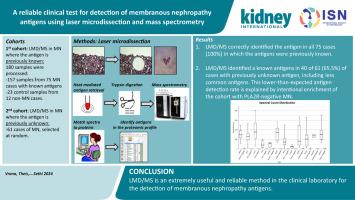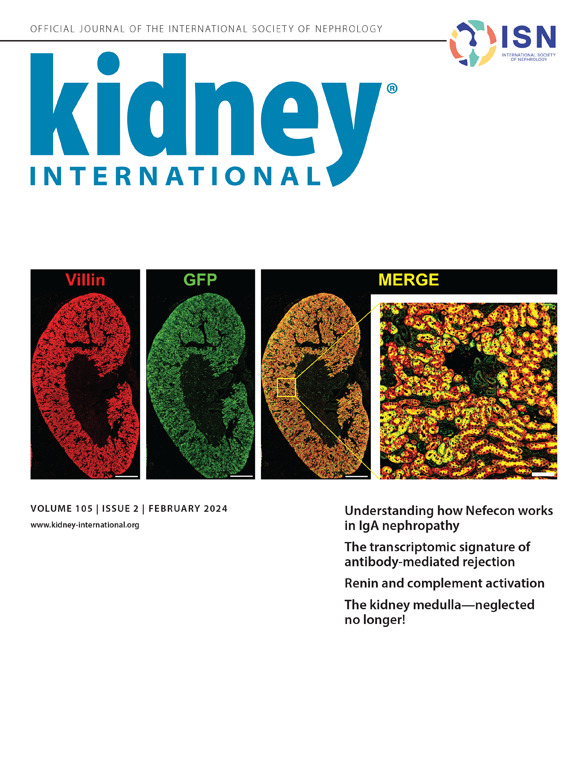利用激光显微切割和质谱技术检测膜性肾病抗原的可靠临床检验。
IF 14.8
1区 医学
Q1 UROLOGY & NEPHROLOGY
引用次数: 0
摘要
膜性肾病(MN)是抗原-抗体免疫复合物沿肾小球基底膜上皮下区域聚集的结果。在过去几年中,已发现 13 种目标抗原,包括 PLA2R、THSD7A、EXT1 和 EXT2、NELL1、SEMA3B、NCAM1、CNTN1、HTRA1、FAT1、PCDH7、NTNG1、PCSK6 和 NDNF,占 MN 抗原的 80-90%。与其中许多抗原相关的 MN 具有独特的临床病理结果。准确鉴定 MN 抗原非常重要。目前,免疫组织化学(IHC)和/或免疫荧光(IF)方法可用于检测 PLA2R、THSD7A、NELL1、SEMA3B 和 EXT1/EXT2。然而,对于其余抗原,IHC/IF 方法并不存在,也不适合检测。在此,我们开发了基于激光显微切割的质谱方法(LMD/MS),作为使用石蜡包埋肾活检组织检测 MN 抗原的一站式临床检测方法。LMD/MS 检测分两个步骤进行验证。LMD/MS 用于检测 75 例已知抗原的 MN 抗原,并正确识别了所有这些病例的抗原。接下来,LMD/MS 被用于识别 61 例抗原未知的 MN 病例中的抗原,并在 61 例病例中的 40 例(包括许多不常见的抗原)中识别出一种已知抗原。之所以检出率低于预期,是因为有意将 PLA2R 阴性的 MN 病例富集到队列中。总体而言,16.4%的病例检测出 PLA2R,49.1%的病例检测出其他抗原之一,其余 34.5%的病例均未检测出上述抗原。因此,LMD/MS 是一种非常有用和可靠的方法,可用于检测已知的 MN 抗原,并有可能为最终发现未知的 MN 抗原提供指示。本文章由计算机程序翻译,如有差异,请以英文原文为准。

A reliable clinical test for detection of membranous nephropathy antigens using laser microdissection and mass spectrometry
Membranous nephropathy (MN) results from accumulation of antigen-antibody immune complexes along the subepithelial region of the glomerular basement membranes. Over the last years, 13 target antigens have been discovered and include PLA2R, THSD7A, EXT1 and EXT2, NELL1, SEMA3B, NCAM1, CNTN1, HTRA1, FAT1, PCDH7, NTNG1, PCSK6 and NDNF, accounting for 80-90% of MN antigens. MN associated with many of these antigens have distinctive clinicopathologic findings. It is important to accurately identify the antigen in MN. Immunohistochemical (IHC) and/or immunofluorescence (IF) methods are currently used to detect PLA2R, THSD7A, NELL1, SEMA3B and EXT1/EXT2. However, for the remaining antigens, IHC/IF methods do not exist and are not practical for detection. Here, we developed laser microdissection-based mass spectrometry methodology (LMD/MS) as a one-stop clinical test for the detection of MN antigens using paraffin-embedded kidney biopsy tissue. The LMD/MS test was validated in two steps. LMD/MS was used to detect the antigen in 75 cases of MN with known antigens and correctly identified the antigen in all these cases. Next, LMD/MS was used to identify the antigen in 61 MN cases where the antigen was unknown and identified one of the known antigens in 40 of 61 cases including many of the less common antigens. This lower-than-expected detection rate is explained by intentional enrichment of the cohort with PLA2R-negative MN. Overall, PLA2R was identified in 16.4%, one of the other antigens detected in 49.1%, and in the remaining 34.5% of cases, none of the above antigens was detected. Thus, LMD/MS is an extremely useful and reliable method for the detection of known MN antigens and possibly indicating an unknown MN antigen for eventual discovery.
求助全文
通过发布文献求助,成功后即可免费获取论文全文。
去求助
来源期刊

Kidney international
医学-泌尿学与肾脏学
CiteScore
23.30
自引率
3.10%
发文量
490
审稿时长
3-6 weeks
期刊介绍:
Kidney International (KI), the official journal of the International Society of Nephrology, is led by Dr. Pierre Ronco (Paris, France) and stands as one of nephrology's most cited and esteemed publications worldwide.
KI provides exceptional benefits for both readers and authors, featuring highly cited original articles, focused reviews, cutting-edge imaging techniques, and lively discussions on controversial topics.
The journal is dedicated to kidney research, serving researchers, clinical investigators, and practicing nephrologists.
 求助内容:
求助内容: 应助结果提醒方式:
应助结果提醒方式:


